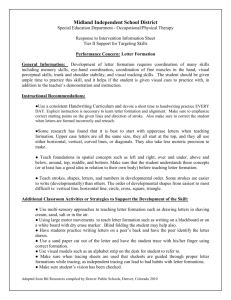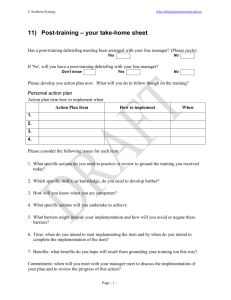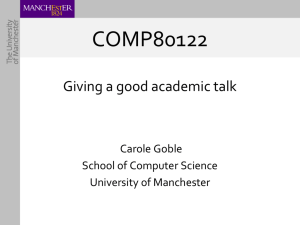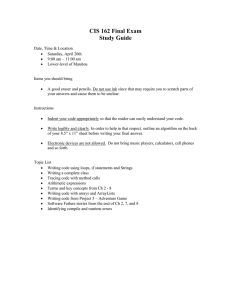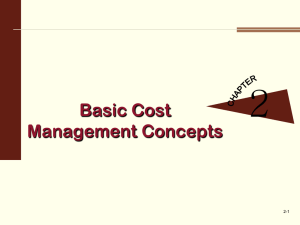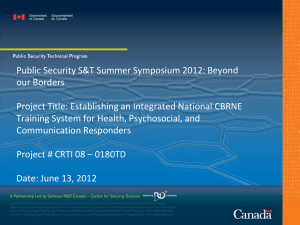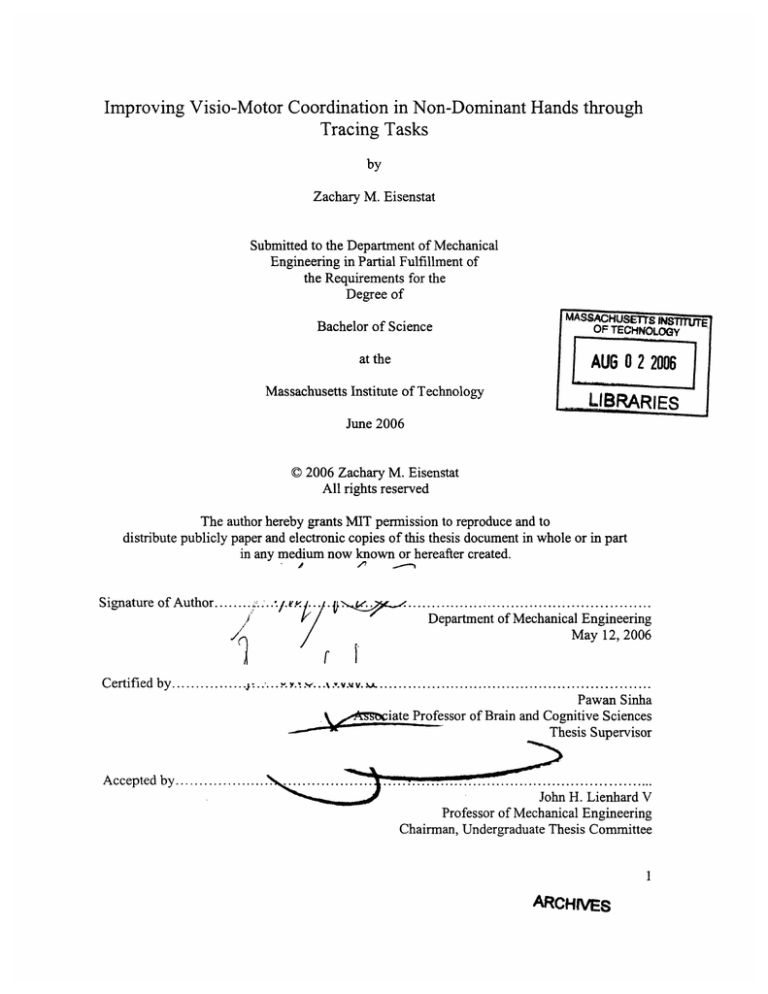
Improving Visio-Motor Coordination in Non-Dominant Hands through
Tracing Tasks
by
Zachary M. Eisenstat
Submitted to the Department of Mechanical
Engineering in Partial Fulfillment of
the Requirements for the
Degree of
MASS~HS~rSt
iNsTrr
ITE
OFTECHNOLOGY
Bachelor of Science
AUG0 2 2006
at the
Massachusetts Institute of Technology
L
June 2006
C 2006 Zachary M. Eisenstat
All rights reserved
The author hereby grants MIT permission to reproduce and to
distribute publicly paper and electronic copies of this thesis document in whole or in part
in any medium now known or hereafter created.
Signatureof Author........:../.:.
0
..rK
.....................................
Department of Mechanical Engineering
May 12, 2006
7r
i,
Certified
by.................
.........................................................
S
Accepted by......
..............................
Pawan Sinha
ciate Professor of Brain and Cognitive Sciences
Thesis Supervisor
V...
John H. Lienhard V
Professor of Mechanical Engineering
Chairman, Undergraduate Thesis Committee
1
ARCHIVES
Improving Visio-Motor Coordination in Non-Dominant
Hands through Tracing Tasks
by
ZACHARY M. EISENSTAT
Submitted to the Department of Mechanical Engineering
on May 12, 2006 in partial fulfillment of the
requirements for the Degree of Bachelor of Science in
Mechanical Engineering
ABSTRACT
Visuo-motor skills are essential in the performance of various everyday tasks. These skills can
be impaired in several neurological conditions. Effective rehabilitation schemes are needed in
order to improve visuo-motor coordination in such subjects. This study will propose and test a
training regimen as a potential approach for improving fine eye-hand coordination. It will also
seek to understand the significance of feedback in visuo-motor improvement. We tested three
groups of subjects: those who received training with feedback, those who received training
without feedback, and a control group that received no training. The results indicate the
effectiveness of our training routine and also highlight the importance of feedback in improving
eye-hand coordination.
Thesis Supervisor: Pawan Sinha
Title: Associate Professor of Brain and Cognitive Sciences
2
Introduction:
Visuo-motor coordination involves the use of visual information to control physical movement.
It is an important skill that allows individuals to successfully function in a wide array of tasks.
Effective visuo-motor coordination is necessary when driving a car, hitting a baseball, picking up
food, playing videogames, or doing any number of other activities.
Through natural development and constant use, visio-motor skills are improved and
perfected.
However, it remains unclear whether significant improvement can be achieved in
adulthood and precisely what kinds of activities might result in improvement. We shall explore
both of these questions in this thesis.
An important dimension along which to probe the second issue (and implicitly the first) is
that of feedback. One possibility is that utilizing the visuo-motor system, in any situation will
help to improve its effectiveness. Another possibility is that the visuo-motor system is improved
more when feedback is available. This would mean that the act of constantly correcting to obtain
a desired result would be an essential factor in strengthening the visuo-motor system.
By assessing the improvement of individuals before and after a training task that involves
or does not involve feedback, this study will attempt to better understand the role of feedback in
visuo-motor improvement. It will also attempt to explore the overall feasibility of fine-visuomotor skill training in adulthood.
A benefit from uncovering an effective training method for fine visuo-motor skills is its
use on individuals with impaired ability. Visio-motor ability is susceptible to many forms of
deterioration and developmental impediments.
This can be caused by visual or muscular
impairment, or through inactivity.
Non-dominant hands are often not used for performing fine motor skills like writing or
drawing. This lack of natural practice and improvement in the non-dominant hand provides us
an excellent opportunity to examine the questions mentioned above in otherwise normal adults.
To assess these two factors, feasibility and feedback importance, this study will look at the
improvement of right-handed individual's left-hand tracing proficiency.
The low level of
proficiency will not only allow for greater improvement, but will also eliminate a great deal of
3
the unintentional training that might occur during the testing period if it were the dominant hand
being tested.
We expect that our results will highlight the importance of feedback in the learning
process and might also yield applied benefits in terms of suggesting a practical and effective
system to assess and develop visio-motor abilities.
Background:
Considering the fundamental nature of the issue, it is perhaps not surprising that a rich body of
work has accumulated, investigating the neurological underpinnings of the highly complex
interaction of visual information and physical action. The visuo-motor transformations seem to
be specific to various types of hand-eye movements (Crawford, et al. 2004). For instance, finehand-eye coordination in rhesus monkey is correlated with saccadic eye movements that center
on specific points of a drawn curve. These fixation points vary with changing hand position,
suggesting eye positioning is set to best benefit hand positioning (Reina and Schwartz, 2003).
It is interesting to consider the specific stages in the developmental progression of handeye coordination. Visually directed grasping has been found to really begin developing during
the fifth month of life. Infants are observed making slow hand movements toward objects with
frequent visual focus shifting between their hand and goal. They are also noted to begin making
attempts at grasping the objects they reach for. Two factors have been found to be critical to this
development: the natural physical motion of the child and the existence of visually stimulating
environmental objects that can provide varying information dependent on the infant's
movements (White, Held, and Castle 1967). The visuo-motor system is found to be extremely
plastic during the early stages of the developmental process. This has been shown as greater
environmental stimulation results in faster reaching development during infancy (White, Held
1967). Finally, at age eight, reaching task accuracy and reaction time are found to be consistent
with adult results. Between the ages of six and seven there is a significant reduction in reaction
time in this eye-hand coordinated task. Also, between seven and eight there is a significant
increase in accuracy (Favilla, 2005).
4
The development of visuo-motor control has been shown to have a dependence on
feedback (White, Held, Castle, 1967). The visuo-motor system is likely making assessments to
best execute visuo-motor activity through internal predictions of outcomes with real-time
sensory feedback (Vaziri et al., 2006). Progressions in adult eye-hand coordination have been
observed, at least for novel tasks. The first stage of learning shows eye movement following the
physical affected stimuli.
environment.
This is to understand the effects of hand movement in this
The second stage shows that visual attention begins to anticipate movement,
allowing vision to assist in more accurate and faster responses. Finally, the third stage shows
that participants merely need to look at their goal to achieve successful motor-movement (Sailer
et al. 2005). While this study does not necessarily show much about the development of the
visuo-motor system, it offers insight into how a developed system learns a novel task. The
results of this study suggest the importance of feedback, specifically in the first, and most
substantial stage, of learning.
While a significant body of work exists concerning benefits of training, for both nonclinical, and clinical individuals, there is little work concerning the actual effects of feedback
(Reina and Schwartz, 2003; Sailer et al., 2005). The present study will seek to begin answering
the question of the importance of feedback and its place in visuo-motor improvement.
Is
movement in response to reference patterns enough to improve eye-hand coordination in fine
motor activities, or is persistent feedback essential to this process? The fine-visuo-motor task
used in this study will attempt to test both the feasibility of visuo-motor skill improvement and
also the significance of feedback.
Methods:
Participants:
Thirty college students were selected to participate in the study.
They consisted of
fourteen (14) females and sixteen (16) males. Every individual was asked whether or not he or
she was right handed. Any individuals who responded that they were not, or that they were
5
ambidextrous, were not included in our group of participants. They were also asked if they
This ensured that the subject
frequently used their left hands for any fine-motor tasks.
population was all right-handed and had little to no left-handed writing or drawing practice.
Stimuli:
We used a large collection of letters drawn from several alphabets. The alphabets were
chosen so as to span a wide range of letter appearances (curved and straight strokes, varying
degrees of letter complexity), and also to be unfamiliar to typical participants in the US. Some of
our stimuli are shown in figure 1.
...I -I. -
I
% .
I
:
. .........
:
II~~~~~~~~~~~~~
3~~
''^'!~~~~~~~
. I .. .
. . .
I..
i
i --
. .
. I.
I
4
L~~~~~~~~~~~~~~~~~~~~~~~~~~~~~
...
....
.:
--
i 3......
..
.,
;.........
~~~~ ~ ~~
'.
.~~~~~~~~~~~~~
..
...
.
.~
.
.
Figure 1: Stimuli used in pre- and post-assessment test.
6
Procedure:
Every participant was administered two pre-training tests. The first test was composed of
fifty unique letters. They were asked to report any images which were familiar to them. Only
one person noted recognizing a letter. With a red felt marker, they were asked to trace the
images (fig.2) on the page with their left hand. They were also asked to spend no more than two
to three seconds on each image. While minor variations in time were noticed, no subject finished
in more than five minutes or less than three minutes.
The reason for instituting a time constraint was to prevent wide discrepancies between
subjects. Also it prevented subjects from adopting unusual strategies (such as very deliberate
and slow movements) with their left-handed tracing.
After tracing with their left hand, participants were given the second pre-training test.
This consisted of the same images, in the same order, as the first test. They were again asked to
trace the images with a red felt pen, though this time with their right hand. Before beginning
they were informed to only spend two to three seconds on each image.
7
f
5
I
I
j
k'
.1..-'
rie"
k
r
1
5
I @
.'
I
I
iIr
.. · i
I...,·c
g
I
i--'
t
h~~~
I
I
U J
~~f
Y~d"
1
Figure 2: A sample page from the assessment test
Following the two pre-training tasks, subjects were randomly split into three equal-sized
groups of ten people each.
Groupl (Subjects received feedback):
These participants were given a packet of seventy pages with four images on each page. The
packet was pre-divided into seven sections of ten pages each. Participants were then told to
practice on ten pages per day. Each of the two-hundred-and-eighty images were unique. They
were informed to only use their left-hand and the red felt marker that they were given during the
8
pre-training test. Aside from this, they were told to avoid any excess training or left-handed
activity. They were also informed that they would be tested again after their week of training.
Group2 (Subjects not given feedback):
These participants were given the same packet as those in group 1. The only different instruction
that they received was that they were to use the back of the pen they received to trace the images.
This meant that no marks were left on the page when they were drawing over the figures.
Group3, Control:
This was the control group. They were given no training packet or task. They were informed
that they would be tested again after seven days.
At the end of the training week every participant was asked back. They were then given the
same fifty images with which they were originally tested. Every individual was then asked to
trace the letters with their left-hand. Again they were informed to only take two to three seconds
on each image.
Data:
Metric of tracing proficiency:
In order to quantitatively assess how well a subject was able to trace a given reference curve, we
used a metric based on the number of crossings of the drawn curve and the reference curve. Two
curves that are exactly alike and perfectly superimposed will yield a metric value of 0 while
curves that are imperfect copies will result in multiple intersections, and therefore a high metric
value.
Effectiveness of Training:
To calculate the effectiveness of the training program for improving eye-hand coordination, the
results of the pre-training left-hand assessment test were compared to the post-training
9
assessment test for each individual. With this information, a one-tailed paired t-test was used to
determine if there was a significant level of improvement in the groups that received training and
the control group.
Training with Feedback:
Right
Left
Final
(Final-Left)
1
95
277
255
-22
2
68
270
199
-71
3
263
405
331
-74
4
106
280
191
-89
5
101
352
256
-96
6
299
333
195
-138
7
214
418
262
-156
8
117
450
231
-219
9
186
446
208
-238
10
179
480
147
-333
Total
1628
3711
2275
-1436
Table 1: Results of the Feedback group's assessment tests
The ten participants who received feedback had the largest reduction in tracing mistakes
between the left-handed pre-training assessment test and the post-training assessment test. The
pre-training test analysis showed that they had traced beyond the boundaries 3,711 times. The
post-training test showed only 2,275 marks outside the tracing images.
Also, in line with
expectation, the right-handed assessment had the fewest errors with only 1,628.
10
Feedback
BAND
4000
I
~ 3500
m 3000
0C)
U)
2500
o 2000
'U 1500
o
1000
0
500
0
Right
Left
Final
Table 2: Graph of the Feedback group's results
The paired t-test resulted in a t score of -4.79 and the standard deviation of the difference
was 94.8. With 9 degrees of freedom, this points to a one-tailed P value of 0.00049. This highly
significant result suggests that there is an improvement in left-handed tracing proficiency
between the two assessment tests for the feedback group. The 95% confidence interval for the
mean is -211.4 to -75.82.
Also noticeable in the data is that every subject in this group improved on their pretraining assessment score. This improvement ranged from 22 to 333 fewer marks beyond the
boundaries.
Training without Feedback:
Right
Left
Final
(Final-Left)
1
216
253
359
106
2
227
269
335
66
3
177
405
378
-27
11
4
187
370
333
-37
5
180
397
347
-50
6
196
501
447
-54
7
253
384
315
-69
8
236
478
339
-139
9
140
531
339
-192
10
342
547
304
-243
Total
2154
4135
3496
-639
Table 3: Results of the Non-Feedback group's assessment tests
The non-feedback group showed less drastic improvement between the left-handed initial
assessment and final assessment. The original test, across all the members of this group, had
4,135 marks outside the specified tracing regions. This improved to a total of 3,496 in the posttraining test. The improvement between the two tests was 639, about 44.5% less than the
progress seen in the feedback group. Again, the right-handed assessment had fewest deviations
with only 2,154 incorrect lines.
No Feedback
4500
'
4000
C
23500
C
3000
O
2500
'C 2000
E
1500
E 1000
E
500
0
Right
Left
Final
Table 4: Graph of Non-Feedback group's results
12
The t-test resulted in a t-score of -1.90 and 9 degrees of freedom. This correlates to a
one-tailed P value of 0.0453. Also, the standard deviation between the groups was 107. The
95% confidence mean is between -140.2 and 12.36. While there is an observable improvement
in tracing errors between the pre- and post-test, an additional t-test comparing results across
groups 1 and 2 shows that there is noticeably more improvement in the feedback group (The
calculated t-score was -1.77, and with 18 degrees of freedom it yielded a P value of .0471).
In group 2, only two participants did not better their pre-training score on the final
assessment. One individual made 66 more errors and another made 106 more. Although two did
not improve, the progress of the other participants ranged from 27 to 243 fewer inaccurate
tracing lines.
Controls:
Right
Left
Final
(Final-Left)
1
254
210
315
105
2
192
408
472
64
3
158
277
336
59
4
216
449
498
49
5
199
362
350
-12
6
264
404
373
-31
7
173
347
314
-33
8
276
391
308
-83
9
306
394
281
-113
10
160
447
259
-188
Total
2198
3689
3506
-183
Table 5: Results of the Control group's assessment tests
The ten controls, receiving no training between their pre-training and post-training
assessment, were analyzed.
Their initial test showed that they had drawn beyond the tracing
boundary 3,689 times. This was 183 more times than the 3,506 times they traced beyond the
boundaries in their final test. They were far more efficient with their right hands, as was
expected, making only 2,198 marks outside the specified regions.
13
Control
4000 -
2 3500o
3000-
o
(n
2500-
0
(
2000-
*·1500
co
I
E
1000-
500
0 Right
Left
Final
Table 6: Graph of Control group's results
The t-test of their data yielded expected results. Comparing their left-handed tracing
abilities pre- and post-training showed a t-score of -0.635, with a standard deviation of 91.2 and
9 degrees of freedom. This meant that the one-tailed P value was 0.271. At the 0.01 level, this is
not significant. Also, the 95% confidence interval for the mean is between -83.54 and 46.94.
These results suggest that there is likely no improvement in the control group's left-handed
tracing ability between the pre-test and post-test.
While there was an improvement in some of the control's assessment scores, 40% had an
increased number of deviations from the tracing boundaries. The range of improving scores was
between 12 and 188 fewer deviations, and the range for increasing number of deviations ranged
from 49 to 105.
To test whether or not the improvement of group 1 and group 2 was significantly greater
than for group 3, two t-tests were performed. The t-test between group 1 and group 2 yielded a tscore of -3.01 with 18 degrees of freedom and a P value of 0.00347. This result is highly
significant and suggests that group l's reduction in mistakes is greater than group 3's.
Alternatively the results for group 2 versus group 3 returned a t-score of -1.03 with 18 degrees of
14
freedom and a P value of 0.159. This implies that group 2's improvement is not significantly
different than group 3's improvement.
Additional Observations:
Lines, whether curved or straight, can be steady or unsteady. The steadier a line is, the
fewer the excursions, or bumps, between the two points that it connects. While this was not a
calculable metric in this study, it certainly was a characteristic that we observed to be different
between the pre-training assessment test and post-training assessment test in many participants.
Comparing the before and after training tests in a member of the feedback group (fig. 3)
shows that even inaccurate lines are drawn much steadier.
This improvement was also
observable in participants from the non-feedback group (fig. 4). Despite a not very significant
result in line deviations for this group, there is clearly an increase in the steadiness of the tracing
lines. While there is a noticeable steadying of lines in the feedback and non-feedback groups,
the controls showed no such progress in their left-handed tracing (fig. 5).
15
a\
Figure 3: Left panel: Sample page from the Feedback pre-training assessment test. Right panel: Sample page
from the Feedback post-training assessment test.
0Q,
K'
Figure 2: Left panel: Sample page from the Non-Feedback pre-training
I'
assessment test. Right panel: Sample
page from the Non-Feedback post-training assessment test.
16
Kg
sk
I-4
"I
Figure 5: Left panel: Sample page from the Control pre-training assessment test. Right panel: Sample page
from the Control post-training assessment test.
Discussion:
This study sought to examine two aspects of visuo-motor learning. The first was whether
or not an effective training regimen could be created to successfully improve fine visuo-motor
skills. The second question concerned the importance of visual feedback in the improvement of
the eye-hand coordination learning. The results of this study show that the answers to both of
these questions are likely to be in the affirmative.
Effectiveness of Training:
The statistically highly significant results from Group 1 suggest that the training regimen
outlined by this study can successfully lead to improved eye-hand tracing ability in the nondominant hand. Also the development in the non-feedback group, while not significant at the .01
level, is certainly noticeable. Also, showing that improvement is not random, or simply achieved
17
by taking the pre-assessment test, the control group showed no significant decrease in their
overall deviations from tracing boundaries between the two tests.
These results suggest that the prescribed training schedule and technique tested in this
study is likely an effective one. The continual act of moving the hand through various patterns,
and observing the congruence of the resulting trajectory with the reference pattern can improve
proficiency on a fine eye-hand coordination task.
Importance of Feedback:
The results of this study strongly suggest that feedback is an important factor in visuomotor learning. Post-training assessment scores for the group with feedback showed far greater
improvement than either of the other groups. The p value of 0.00049 suggests that it is highly
unlikely that this improvement was random.
Feedback's role in visuo-motor coordination development is further confirmed by this
study's results. While it has previously been shown that altered feedback can distort eye-hand
development and learning, our study suggests that feedback is important in exacting significant
change or improvement on the coordination of the eye and hand.
Improvement of Non-Feedback Group:
Although not found to be very statistically significant, there is a certainly a trend towards
improvement in tracing ability between the pre-training assessment and post-training assessment
test results. This suggests that, while feedback is important for improvement, there are other
factors involved in this learning process.
Simply stated, this suggests that training without
feedback may be more effective than doing nothing.
Despite the limited effectiveness of non-feedback training for improving fine visuo-motor
coordination, this training did lead to another type of improvement. While not accounted for
quantitatively, the steadiness of lines certainly showed signs of improvement between the first
and final assessment tests.
Line Steadiness:
18
In both the feedback and non-feedback groups there was a noticeable steadying of the
drawn lines. A majority of the participants drew shaky lines when tracing the given images.
These excursions from the intended line accounted for many of the mistakes in all of the pretraining assessment tests.
While the post-training tests did not show a complete disappearance of this jitter, the
deviations from the intended line were far less frequent and much subtler for the feedback and
non-feedback results.
As expected, the control groups showed little to no change in the
steadiness of their lines.
Although it can be said that the steadiness of a line is a product of eye-hand coordinated
movement, it is likely more dependent on motor control alone. This would account for the
improvement in the two groups that received training during this study. These two groups,
feedback and non-feedback, were using their left hands to perform fine-motor skills everyday for
a week. Regardless of feedback, they were attempting similar hand movements. This likely
caused a slight development in their left hand motor manipulation.
Assessing the increased steadiness this way accounts for why both groups had noticeable
improvement, while the control group's steadiness remained the consistent over the course of the
study. This would also account for some of the improvement seen in the non-feedback group's
post-test results.
Conclusion:
This experiment showed that an effective training regimen can be implemented to
improve the visuo-motor coordination of the left hand in right-handed individuals. Given the
appropriate conditions, there is a significant improvement in the fine eye-hand coordination task
of tracing. Feedback was found to be an essential piece for the successful execution of a training
program. Despite a noticeable improvement in the non-feedback group, the only group to truly
see impressive and significant improvement was the feedback group.
19
These results support the current notions concerning the importance of feedback. While
it has been noted as an integral piece of eye-hand development (White, et al. 1967), and as a
necessary dimension to learning tracking and pointing paradigms (Roerdink, et al. 2005), this
study additionally suggests that feedback plays a critical role in visuo-motor improvement.
Although not calculated, it is likely that a significant proportion of the observable
improvement in the non-feedback group is due to the steadying of their lines. While eye-hand
skills development could be the cause for the majority of their progress between the pre-training
and post-training assessment, it is more likely to be from their improvement in left-hand motor
control. For future studies, it would be helpful to calculate the beneficial effect of straighter lines
on decreasing the number of deviant marks. This could allow for a more accurate measurement
of the improvement gained through improvement in eye-hand coordination versus the
improvement in motor control per se.
Moving forward it would be worthwhile to understand how much feedback is necessary,
and whether more information or less information would affect the level of improvement
between pre- and post-training tests. Tracing images on a tablet pc could allow for the setting of
various levels of feedback, from making sounds every time a participant leaves the boundaries of
the tracing image to fading the tracing line to barely visible levels.
This study could also be performed in groups who have impaired visuo-motor skills. The
results would help to highlight not only their potential for improvement, but also whether
feedback is as able to be as effective in restoring any eye-hand coordination. Developing this
task would not only garner information regarding the rehabilitation of specific clinical
populations, but also provide a possible training regimen to help improve a stroke victim's or
late-sight-onset individual's ability to gain or re-gain visuo-motor coordination.
In summary, we have shown that there exist effective training regimens to improve visuomotor coordination of fine-motor skills. Essential to this training regimen is the use of feedback.
This study shows that training, with feedback, yields impressive and significant improvement in
non-dominant hand tracing ability. This helps to not only illuminate the necessity of feedback in
visuo-motor learning, but also provides guidelines for how to best create effective techniques for
at least some forms of visuo-motor rehabilitation.
20
References:
Battaglia-Mayer
et al., 2001
Battaglia-Mayer,
A. Ferraina,S.
Genovesio,
A. Marconi,
B.
Squatrito, S. Molinari, M. Lacquaniti, F. Caminiti, R., "Eye-Hand Coordination during
Reaching. II. An Analysis of the Relationships between Visuomanual Signals in Parietal Cortex
and Parieto-frontal Association Projections," Cerebral Cortex. 11: pp.528-544, 2001.
Bonifacci., 2004 Bonifacci, P., Human Movement Science. 23: pp. 157-168, 2004.
Crawford et al., 2004 Crawford, J. Medendorp, W. Marotta, J., "Spatial Transformations for EyeHand Coordination," The Journal of Neuroscience. 92: pp. 10-19, 2004.
Favilla, 2005 Favilla, M., "Reaching movements in children: accuracy and reaction time,"
Experiment Brain Research. 169: pp. 122-125, 2005.
Land, 2005 Land, M., "Eye-Hand Coordination: Learning a New Trick," Current Biology.
15(23): 2005.
Mascaro et al., 2003 Mascaro, M. Battaglia-Mayer, A. Nasi, L. Amit, D. Caminiti R., "The Eye
and Hand: Neural Mechanisms and Network Models for Oculomanual Coordination in Parietal
Cortex," Cerebral Cortex. 13: pp. 1276-1286, 2003.
Poggio and Bizzi, 2004 Poggio, T. Bizzi E., "Generalization in vision and motor control,"
Nature. 431: pp.768-774, 2004.
Reina and Schwartz, 2003 Reina, G. Schwartz, A., "Eye-hand coupling during closed-loop
drawing: Evidence of shared motor planning?" Human Movement Science. 22: pp.137-152,
2003.
Roerdink et al., 2005 Roerdink, M. Peper, C.E. Beek, P.J., "Effects of correct and transformed
visual feedback on rhythmic visuo-motor tracking: Tracking performance and visual search
behavior," Human Movement Science. 24: pp.379-402, 2005.
White, Held, and Castle., 1967 White, B. Held, R., Castle, P., "Observations on the Development
of Visually-Directed Reaching," Experience in Early Human Development. pp.269-289, 1967.
White and Held., 1967 White, B. Held, R.., "Plasticity of Sensorimotor Development in the
Human Infant," Experience in Early Human Development. pp.2 9 0 - 3 1 3, 1967.
Sailer et al., 2005 Sailer, U. Flanagan, J. Johansson, R., "Eye-Hand Coordination during
Learning of a Novel Visuomotor Task," The Journal of Neuroscience. 25(39): pp.8833-8842,
2005.
Vaziri et al., 2006 Vaziri, S. Diedrichsen, J. Shadmehr, R., "Why Does the Brain Predict Sensory
Consequences of Oculomotor Commands? Optimal Integration of the Predicted and the Actual
Sensory Feedback," The Journal of Neuroscience. 26(16): pp.4 1 8 8 - 4 197, 2006.
21
MITLibraries
Document Services
Room 14-0551
77 Massachusetts Avenue
Cambridge, MA 02139
Ph: 617.253.5668 Fax: 617.253.1690
Email: docs@mit.edu
http: //libraries. mit.edu/docs
DISCLAIMER OF QUALITY
Due to the condition of the original material, there are unavoidable
flaws in this reproduction. We have made every effort possible to
provide you with the best copy available. If you are dissatisfied with
this product and find it unusable, please contact Document Services as
soon as possible.
Thank you.
Some pages in the original document contain color
pictures or graphics that will not scan or reproduce well.

